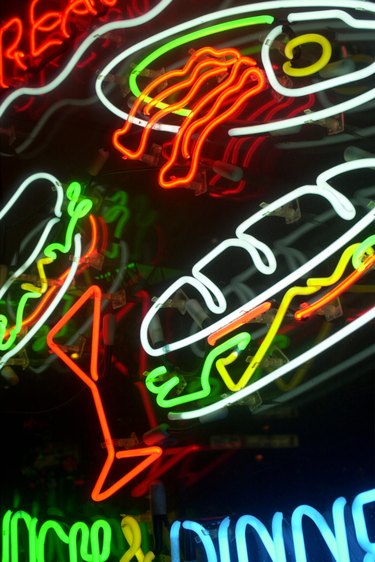
Besides being one of the most attractive options for colorful signage, neon tubes are a comparatively energy-efficient light source that consumes much less power relative to the brightness of the light it puts out, than incandescent or fluorescent light sources do. Only the newest light-emitting diode technologies challenge neon when it comes to efficient colored light.
Neon Power Consumption
Video of the Day
Measure the power consumption of a linear light source like a neon tube by using a ratio of watts used per foot of neon. The power consumption of a given neon tube depends on the type of transformer used and the color of the neon, but consumption of 3 1/2 to 4 watts per foot for red neon is typical. That means that a foot of red neon tube that burns for 12 hours per day will consume from 15.33 to 17.52-kilowatt hours of electricity per year. Measure the efficiency of neon as a proportion of lumens -- a unit of light output -- per watt.
Video of the Day
Compared to LED
Light-emitting diodes are suggested as energy-efficient alternatives to neon tubes, but the comparisons, which often claim a 90 percent energy savings for LED, often fail to take into account the relative inefficiency of LED light sources as compared to neon. While an LED light source of a similar color and size to neon may consume less power, a foot of LED tube lighting left on for 12 hours per day may consume as little as 3.5 kWh per year; the LED typically outputs much less light than the neon tube. Adjusting the brightness of the LED for comparison to neon, the difference in power consumption is less pronounced.
Compared to Fluorescent and Incandescent
When compared to a fluorescent bulb, neon is much more efficient, with a fluorescent fixture consuming more than 50 percent more power than a comparable neon light source. High output fluorescent bulbs consume even more power; a foot of HO fluorescent tube consumes 70 kWh per year when burned 12 hours per day. The difference in power consumption between neon and incandescent bulbs is even greater; incandescent bulbs can consume up to four times as much power as similar fluorescent bulbs.
Alternatives
Although the difference in power consumption between neon and LED light sources is not as great as it might first appear to be, LEDs have other advantages that can make them an attractive alternative to neon. New flexible LED tube lights mimic the look of neon but are more durable and long lasting. They are resistant to water and humidity, produce almost no heat and are capable of producing lighting effects that traditional neon cannot achieve.